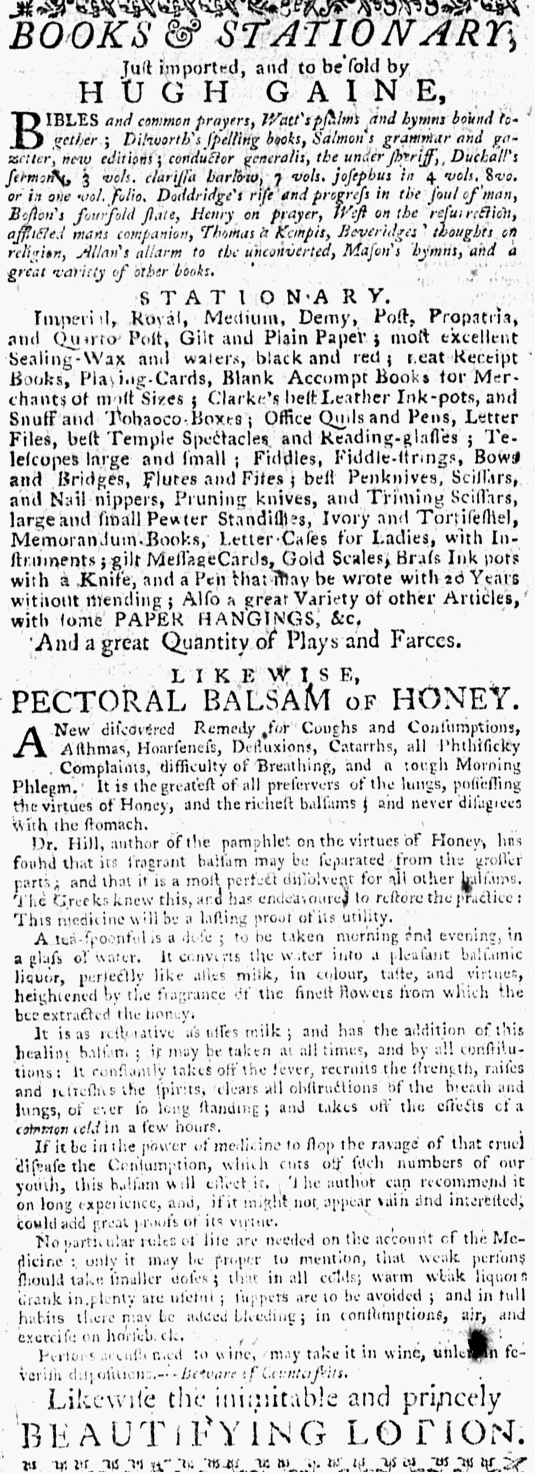GUEST CURATOR: Grace Crowley
What was advertised in a colonial American newspaper 250 years ago today?

“A LIBRARIAN IS wanted by the LIBRARY COMPANY of Philadelphia.”
What caught my eye about this advertisement was the need for a librarian at the Library Company of Philadelphia, as I have been working with Laura Wasowicz, the curator of children’s literature at the American Antiquarian Society, for my independent research project for my capstone history seminar. I was interested in what the Library Company of Philadelphia was in the eighteenth century and I was excited to find out the Library Company, sometimes known as the LCP, is still alive and well today! According to their website, the LCP is America’s “first successful lending library and oldest cultural institution,” founded by Benjamin Franklin and the members of the Junto in 1731. The Junto Club was a collection of friends, including Benjamin Franklin, who met on Friday evenings to discuss different issues regarding morals, politics, or philosophy. These men were a collection of tradesmen and artisans who were interested in the common good for themselves and their society and were dedicated to finding ways to bring improvements to both. Members of the Junto were devoted readers and believed that if more people in their community had access to books they were reading, it would motivate those people to think and learn on their own, which could improve society.
Franklin wanted the public to have easy access to books since, at this time, books were not readily available and if available were extremely expensive. The members of the Junto themselves, most of them artisans, were not able to afford these books on their own either. Franklin and fifty other shareholders decided to collaborate and contribute forty shillings to buy the original collection of books and ten shillings every year to grow the library’s collection. The Junto was a catalyst for many public projects including this first lending library, the Library Company of Philadelphia.
The collection has grown throughout many different eras of American society and remains open to a variety of readers, from high school students to senior scholars. The Library Company of Philadelphia serves as a library full of resources that focus on American society and culture from the seventeenth century through the nineteenth century. Their mission is to increase the public understanding of American history by preserving and sharing the materials in their collection.
**********
ADDITIONAL COMMENTARY: Carl Robert Keyes
The edition of the Pennsylvania Journal that first carried the Library Company of Philadelphia’s advertisement seeking a librarian also carried several advertisements for books, some of them available from printers and booksellers, others in the press, and some proposed for publication if enough subscribers reserved copies. Throughout the colonies, printers and other members of the book trade sometimes placed a disproportionate amount of advertising in newspapers.
Subscription proposals outnumbered other advertisements for books in that issue of the Pennsylvania Journal. One presented to the “GENTLEMEN and LADIES of America. PROPOALS For PRINTING by SUBSCRIPTION, THE History of the Life and Adventures OF Mr. DUNCAN CAMPBELL, (Born DEAF and DUMB).” It would go to press “as soon as a sufficient number of SUBSCRIBERS offer.” To entice them, the proposals promised “a curious well engraven PLATE, shewing the method how the deaf and dumb may obtain the knowledge, and be taught to read and write any language.” For booksellers and shopkeepers who might be inclined to purchase by volume for retail, “Those who subscribe for twelve Books [would] have a thirteenth gratis.” Another subscription proposal offered “THE CELEBRATED American EDITION OF THE WORKS OF FLAVIUS JOSEPHUS.” Those who chose to have their volumes bound “shall have their names at large on the inside of the cover, done in Gold Letters.” In addition, James Rivington promoted his edition of “NEW VOYAGE ROUND THE WORLD,” detailing Captain James Cook’s voyage on the Endeavour from 1768 through 1771.
By way of updating subscribers, James Humhreys, Jr., informed them that “STERNE’s WORKS” had been delayed due to “an unlucky accident, by which he has been confined and disabled from work for some weeks past.” He pledged that the first volume was “now almost finished, and will be published in a few weeks, embellished with an elegant copper-plate Frontispiece.” The printer also hawked a “New Edition of Whittenhall’s Latin Grammar” and “several other School Books.” Elsewhere in that issue of Pennsylvania Journal, Robert Bell announced an “EXHIBITION of NEW and OLD BOOKS BY AUCTION.” He anticipated the sale would last “eight or ten evenings.” Readers could bid and acquire books from various genres, including “Arts, Sciences, History, Divinity, Biography, … Poetry, Classics, Voyages, Travels, [and] Novels.” One advertisement even discouraged readers from purchasing a book. Thomas Say once again ran his notice pleading with the public to refrain from buying William Mentz’s unauthorized edition of “The Vision of Thomas Say.”
Perhaps some of these books eventually found their way into the collections of the Library Company of Philadelphia, either in the eighteenth century when printers originally published and sold them or in subsequent years as the Library Company collected early American imprints and became a major research library. Advertisements placed by printers, the Library Company, and even the aggrieved Thomas Say all testified to the contours of print culture in the largest city in the colonies on the eve of the American Revolution.





